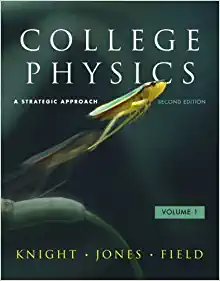Question
Explain what is meant by field and compare the properties of gravitational, electric, and magnetic forces in terms of particles affected, factors affecting the magnitude,
Explain what is meant by "field" and compare the properties of gravitational, electric, and magnetic forces in terms of particles affected, factors affecting the magnitude, and their relative strengths.
If the force of gravity between a book of mass 0.50 kg and a calculator of 0.100 kg is 1.5 10-10 N, how far apart are they?
Draw diagrams showing the following: (a) The electric field around a positive charge
(b) The electric field between two parallel plates with the upper plate being negative (c) The magnetic field around a bar magnet (d) The magnetic field around a horizontal straight current-carrying conductor that has current travelling to the right
If the electric force between two charges is 4.2 10-2 N, what would the new force be if the distance between the charges is doubled and the charge on one of the charges is tripled?
What would be the electric field (magnitude and direction) of 1.50 cm to the right of a charge of -6.5 10-6 C?
Two 1.0 kg charges each carry a charge of 1.0 C? How would the gravitational force compare to the electric force? (Calculations are not necessary.)
A point charge has an excess of 5.0 1012 electrons. What would be the electric potential at a distance of 0.50 m from the charge? (e = 1.6 10-19 C)
A positively charged particle is fixed in place, unable to move. Another charged particle is brought near and released.
(a) Which way does it move? (b) What happens to the force, acceleration, and velocity on the moving particle as it moves? (c) What happens to the charges' electric potential as it moves?
How is the electric field between parallel plates different from the electric field around a charged sphere?
There are two situations in which it possible for a charged particle to be in a magnetic field but not experiencing a magnetic force. What are they? (Hint: Looking at the equation for magnetic force will help!)
Is it true that a magnetic field can cause an increase in the kinetic energy of a charged particle? Why or why not?
Calculate the speed required for a satellite moving in a circular orbit 550.0 km above the surface of the Earth. (mEarth = 5.98 1024 kg , rEarth = 6.38 106 m)
n an experiment replicating Millikan's oil drop experiment, a pair of parallel plates are placed 0.0200 m apart and the top plate is positive. When the potential difference across the plates is 240.0 V, an oil drop of mass 2.0 10-11 kg gets suspended between the plates. (e = 1.6 10-19 C) (a) Draw a free-body diagram for the charge. (b) What is the charge on the oil drop?
(c) Is there an excess or deficit of electrons on the oil drop? How many electrons are in excess or deficit?
a) An electron starts at rest and accelerates through an electric field established by a set of parallel plates with a potential difference of 35 V. What is the speed of the electron the instant before it hits the negative plate? (e = 1.6 10-19 C, melectron = 9.1 10-31 kg) (b) Instead of hitting the negative plate, the electron, travelling East, escapes the parallel plates through a small hole and enters a magnetic field of 0.75 T directed downward. What will be the magnetic force (magnitude and direction) on the charge? (c) Once the electron has entered the magnetic field, it is in circular motion. What is the radius of the electron's circular path?
Step by Step Solution
There are 3 Steps involved in it
Step: 1

Get Instant Access to Expert-Tailored Solutions
See step-by-step solutions with expert insights and AI powered tools for academic success
Step: 2

Step: 3

Ace Your Homework with AI
Get the answers you need in no time with our AI-driven, step-by-step assistance
Get Started


